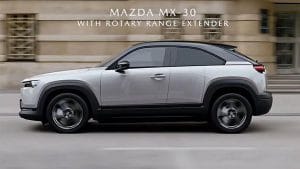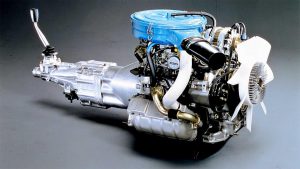
Mazda’s first EV will be the MX-30 SUV, which debuted in concept form at last year’s Tokyo Motor Show.
Search TheDetroitBureau.com’s archives and you’ll find plenty of stories suggesting that Mazda intends to revive the rotary engine – or at least it would like to were it to find an appropriate application.
Has the right opportunity finally turned up? Very possible, based on one of the nuggets tucked into a special video the Japanese automaker has put together to mark its 100th anniversary.
The rotary played an important role in Mazda’s first century. While it had some clear advantages, it had a number of drawbacks, as well. But the automaker may have found precisely the right application to play to the Wankel engine’s strengths – as a range-extender for the MX-30 electric vehicle Mazda is planning to bring to market in the coming year.
Referencing an electric prototype it had previously developed, the Mazda2 EV, the automaker said, “A similar system could find its way onto the Mazda MX-30, a brand new battery electric crossover SUV arriving at dealerships this year.”
(First Drive: 2020 Mazda6 Signature Edition.)
The rotary engine, more formally known as the Wankel, was developed, appropriately enough by German engineer Felix Wankel back in the 1920s, though the first working prototype took until 1957 when he was working at NSU, one of the carmakers eventually absorbed into today’s Audi. The German company licensed the concept out and a number of manufacturers, including AMC and General Motors, planned to put the rotary into production. But, with the exception of Mazda, that never happened.
Rotary engines are incredibly small and light and use relatively few moving parts, primarily a triangular, spinning rotor that substitutes for the pistons found in more familiar internal combustion engines. For their size they can produce tremendous amounts of power – but they do have drawbacks.
That starts with the seals around the three rotor tips – frequent failures nearly bankrupted Mazda in the 1970s until it found a fix. But Wankels have other, fundamental challenges. They aren’t very efficient in automotive environments revving up and down constantly.Rotaries could be far more efficient, however, when running at relatively steady speeds – as they would serving as a range-extender.
(Mazda squeezes the new CX-30 into its expanding crossover line-up)
For those unfamiliar with the concept, BMW already offers one example in the form of the i3Rex where a compact I-3 gas engine kicks in when the electric city car’s batteries run down or need an extra boost to meet the demand for more power. That approach allows a small battery-electric vehicle to maintain a smaller – and less expensive – battery pack but still have the ability to keep going when the pack runs down. Unlike a conventional plug-in hybrid, range-extenders only generate power for the vehicle’s electric motors and never directly send torque to the wheels.
That would be a potentially perfect way to handle things for the MX-30, the concept version of which made its debut at the Tokyo Motor Show last autumn. In prototype form it featured a relatively small 35.5 kilowatt-hour lithium-ion battery paired with a 141 horsepower electric motor driving the front axle. Range was limited to around 130 miles using the European test cycle – likely around 100 miles with the U.S. EPA test. To supplement the battery, the MX-30 featured a small version of Mazda’s SkyActive-G gas engine that could roughly double range.
(Mazda Miata tops 2020 reliability list)
Mazda has been vague with details about plans for the production MX-30. It would clearly meet the needs of Japanese drivers, and possibly Europeans, as well. A U.S. application is another matter entirely, especially in light of the slow take-off of American BEV sales.
There would clearly be fans excited to see the return of the rotary, however. The engine hasn’t been used to power a Mazda product since the RX-8 sports car went out of production in June 2012. All told, Mazda produced about 811,000 of the Wankels.



Similar to a diesel-electric locomotive?
In a sense, William, but there the diesel is always running. Here it is used to supplement the battery which is the go-to source for power, if you will, as long as there is charge left. If not, the extender engine (whatever form it takes) would take over.
Paul E.